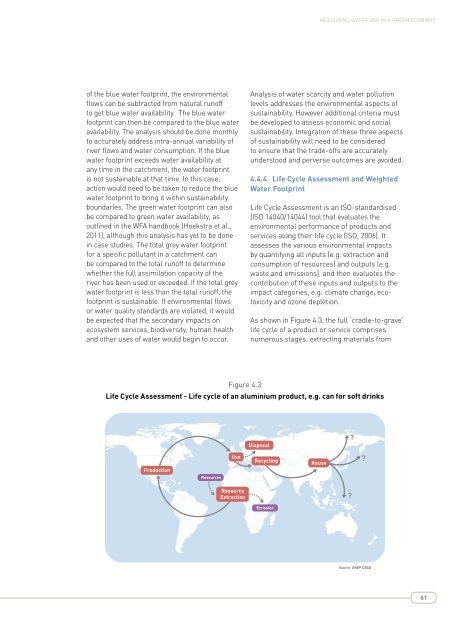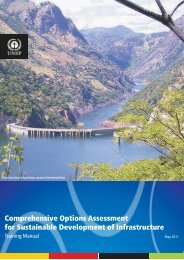MEASURING WATER USE IN A GREEN ECONOMY - UNEP
MEASURING WATER USE IN A GREEN ECONOMY - UNEP
MEASURING WATER USE IN A GREEN ECONOMY - UNEP
Create successful ePaper yourself
Turn your PDF publications into a flip-book with our unique Google optimized e-Paper software.
Measuring water use in a green economy<br />
of the blue water footprint, the environmental<br />
flows can be subtracted from natural runoff<br />
to get blue water availability. The blue water<br />
footprint can then be compared to the blue water<br />
availability. The analysis should be done monthly<br />
to accurately address intra-annual variability of<br />
river flows and water consumption. If the blue<br />
water footprint exceeds water availability at<br />
any time in the catchment, the water footprint<br />
is not sustainable at that time. In this case,<br />
action would need to be taken to reduce the blue<br />
water footprint to bring it within sustainability<br />
boundaries. The green water footprint can also<br />
be compared to green water availability, as<br />
outlined in the WFA handbook (Hoekstra et al.,<br />
2011), although this analysis has yet to be done<br />
in case studies. The total grey water footprint<br />
for a specific pollutant in a catchment can<br />
be compared to the total runoff to determine<br />
whether the full assimilation capacity of the<br />
river has been used or exceeded. If the total grey<br />
water footprint is less than the total runoff, the<br />
footprint is sustainable. If environmental flows<br />
or water quality standards are violated, it would<br />
be expected that the secondary impacts on<br />
ecosystem services, biodiversity, human health<br />
and other uses of water would begin to occur.<br />
Analysis of water scarcity and water pollution<br />
levels addresses the environmental aspects of<br />
sustainability. However additional criteria must<br />
be developed to assess economic and social<br />
sustainability. Integration of these three aspects<br />
of sustainability will need to be considered<br />
to ensure that the trade-offs are accurately<br />
understood and perverse outcomes are avoided.<br />
4.4.4 Life Cycle Assessment and Weighted<br />
Water Footprint<br />
Life Cycle Assessment is an ISO-standardised<br />
(ISO 14040/14044) tool that evaluates the<br />
environmental performance of products and<br />
services along their life cycle (ISO, 2006). It<br />
assesses the various environmental impacts<br />
by quantifying all inputs (e.g. extraction and<br />
consumption of resources) and outputs (e.g.<br />
waste and emissions), and then evaluates the<br />
contribution of these inputs and outputs to the<br />
impact categories, e.g. climate change, ecotoxicity<br />
and ozone depletion.<br />
As shown in Figure 4.3, the full ‘cradle-to-grave’<br />
life cycle of a product or service comprises<br />
numerous stages: extracting materials from<br />
Figure 4.3<br />
Figure 4.3<br />
Life cycle of an aluminium product, e.g. can for soft drinks<br />
Life Cycle Assessment - Life cycle of an aluminium product, e.g. can for soft drinks<br />
Disposal<br />
?<br />
Production<br />
Resources<br />
Use<br />
Recycling<br />
Reuse<br />
?<br />
Resource<br />
Extraction<br />
?<br />
Emission<br />
Source: <strong>UNEP</strong> (2002)<br />
61

















